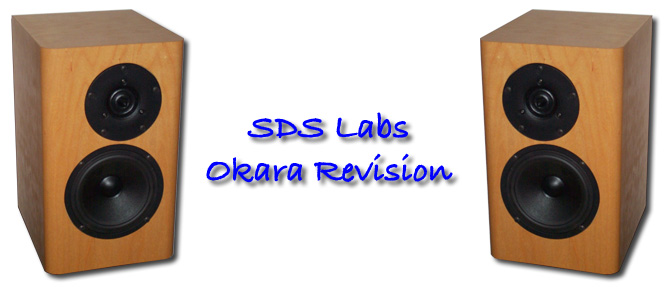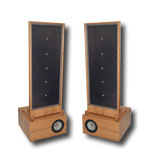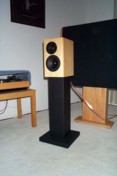This project started when I saw the beautiful little cabinets that Ken Martinez made. These enclosures are based on a North Creek Music Systems design. These cabinets are very solid, with a 1.5" MDF and baltic birch plywood front and rear baffles. The sides top and bottom are 0.75" MDF and there is a 0.75" birch plywood brace running through the center of the cabinet. The design is a ported extended bass shelf tuning with a 3 dB point at about 60 Hz.
The original North Creek design uses the super smooth Vifa P13WH 5.5" woofer. This thing doesn't have a lot of bass extension, but what it does it does very well. The original design also uses the Scan-Speak 9500 tweeter.
About the same time I purchased these cabinets, some friends were waxing poetic about the new Vifa XT-25 ring-radiator tweeter. Given my distaste for every dome tweeter I've ever tried (I'm a planer and ESL guy), I thought that the XT-25 would be a good experiment to see if it is really an improvement over that typical dome tweeter sound. Everything I had heard about the P13 was very positive, and the box was tuned for that driver, so I figured that I should stick with it. The XT-25 drops right into the same hole cut for the 9500 (although it's a bit thicker faceplate), so it seemed like an easy tweeter to try.
A friend and I were intrigued by the Acoustic Reality series crossover. This crossover looks very good on paper with just a few components and what seemed like inevitably good driver integration. So as a first test we decided to build up a set of the AR Series crossovers. The XT-25 tweeter thinks it's a midrange, and just won't naturally roll off like a more traditional tweeter. This characteristic combined with a rising impedance in the crossover region (this tweeter has no ferrofluid) means that with this serial crossover, it's really hard to keep low frequency energy out of the tweeter. The AR SXO is an interesting thing. The driver impedance relationship between the tweeter and woofer determing the crossover point, and adjusting the crossover components act to raise or lower the output from each driver but won't change the fundamental crossover point. Changing values acts like a teeter-totter on a fixed crossover point. After a lot of trial and error we arrived at a fairly flat response. However the speaker sounded harsh and stressed when we listened to it. It is my belief that there was just too much low frequency energy getting to the tweeter. this crossover topology may work really well for some driver combinations, but I don't think this is one of them.
That lack of crossover point control and inevitable interactions between the drivers in the series crossover prevented me from getting the response I wanted out of each driver and ultimately the sound I was looking for from this speaker. So I decided to abandon the series crossover and lemming along with a parallel scheme.
My foray into dynamic speaker design started by buying a wide range of typical capacitor, inductor, and resistor values for proto-typing crossovers. I also built a pair of proto-boards for assembling these crossovers in an easy and timely manner.
At this point, I realized that these speakers probably wouldn't be used on shelves and I should build a set of stands. Some pictures of my stands are shown below. they are constructed from 3/4" MDF and are sand fillable.
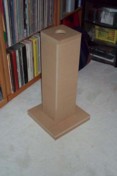
|
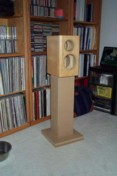
|
After playing around with a lot of different crossover orders, I found that the XT-25 tweeter just doesn't want to roll off. I couldn't get it to roll off and not sound harsh trying to reproduce low frequencies. So I kept increasing the order of the filters. I've ended up with a third order electrical on both the woofer and tweeter. The tweeter has an L-Pad on it for level matching and taming the nasty resonance peak (this tweeter has no ferro-fluid damping). The woofer has a zobel on it. The crossover schematics are shown below:
A couple pictures of my crossovers are shown below. They use 12 gauge Alpha Core Inductors and polyprop caps.

|
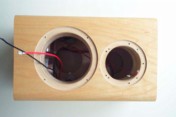
|
After installing the crossover and screwing them to the cabinet walls, I lined the cabinet with a mix of cotton batting and polyfil. The ports in the back of the cabinets are stuffed with straws. The straws allow the port length to be tuned easily. The speaker measurements are shown below:
This speaker images amazingly well, as you would expect from a small speaker like this. Also like a small speaker with a small woofer, it lacks weight and bass extension. It does reasonably well when placed near the back wall. However as bass reinforcement increases as the speaker gets closer to the back wall, imaging suffers. The tweeter is quite clear and less harsh than the vast majority of the other dome tweeters that I have heard; it's still no electrostatic driver though. With a good subwoofer, these speakers would make a fine audio system. However, without a subwoofer, I'm not sure I'd recommend them, they just lack the weight and fullness that I would like. A 5.25" woofer just isn't quite full range.
